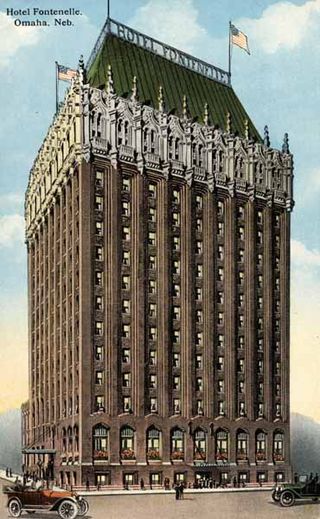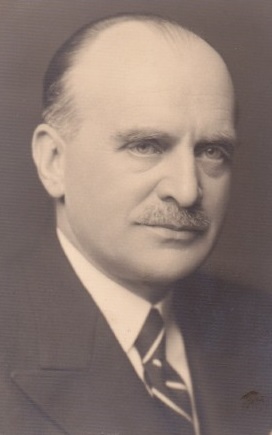Related Research Articles

The University of Nebraska–Lincoln is a public land-grant research university in Lincoln, Nebraska, United States. Chartered in 1869 by the Nebraska Legislature as part of the Morrill Act of 1862, the school was the University of Nebraska until 1968, when it absorbed the Municipal University of Omaha to form the University of Nebraska system. It is the state's oldest university and the flagship institution of the state-wide system. The university has been governed by the Board of Regents since 1871, whose members are elected by district to six-year terms.

Šumperk is a town in the Olomouc Region of the Czech Republic. It has about 25,000 inhabitants. It is an industrial town, but it also contains valuable historical and architectural monuments. The historic town centre is well preserved and is protected by law as an urban monument zone.

The Admiral Theatre is located at 2234 South 13th Street in the Little Bohemia neighborhood of South Omaha, Nebraska. It is a local icon for its historical context, as well as modern musical performances for rock and country music. It has a maximum capacity of 1,500. It was originally known as the Sokol Auditorium from 1926 to 2021.

Sokolov is a town in the Karlovy Vary Region of the Czech Republic. It has about 22,000 inhabitants.
Sokol most commonly refers to the Sokol movement, a Pan-Slavic physical education movement, and its various incarnations:

Nusle is a district of Prague. It became part of the city in 1922.

The history of Omaha, Nebraska, began before the settlement of the city, with speculators from neighboring Council Bluffs, Iowa staking land across the Missouri River illegally as early as the 1840s. When it was legal to claim land in Indian Country, William D. Brown was operating the Lone Tree Ferry to bring settlers from Council Bluffs to Omaha. A treaty with the Omaha Tribe allowed the creation of the Nebraska Territory, and Omaha City was founded on July 4, 1854. With early settlement came claim jumpers and squatters, and the formation of a vigilante law group called the Omaha Claim Club, which was one of many claim clubs across the Midwest. During this period many of the city's founding fathers received lots in Scriptown, which was made possible by the actions of the Omaha Claim Club. The club's violent actions were challenged successfully in a case ultimately decided by the U.S. Supreme Court, Baker v. Morton, which led to the end of the organization.
The Near North Side of Omaha, Nebraska is the neighborhood immediately north of downtown. It forms the nucleus of the city's historic African-American community, and its name is often synonymous with the entire North Omaha area. Originally established immediately after Omaha was founded in 1854, the Near North Side was once confined to the area around Dodge Street and North 7th Street. Eventually, it gravitated west and north, and today it is bordered by Cuming Street on the south, 30th on the west, 16th on the east, and Locust Street to the north. Countless momentous events in Omaha's African American community happened in the Near North Side, including the 1865 establishment of the first Black church in Omaha, St. John's AME; the 1892 election of the first African American state legislator, Dr. Matthew Ricketts; the 1897 hiring of the first Black teacher in Omaha, Ms. Lucy Gamble, the 1910 Jack Johnson riots, the Omaha race riot of 1919 that almost demolished the neighborhood and many other events.

The culture of Omaha, Nebraska, has been partially defined by music and college sports, and by local cuisine and community theatre. The city has a long history of improving and expanding on its cultural offerings. In the 1920s, the Omaha Bee newspaper wrote, "The cultural future of Omaha seems as certain of greatness as the commercial future... The symphony orchestra, the Art institute, the Community Playhouse and other organizations are on firm foundations and Omaha is destined to be not only a bigger, but a better city, both financially and culturally." Reviewing Omaha's contemporary arts scene in 2007, the New York Times hailed the city as having "a kind of cultural awakening".

Little Bohemia, or Bohemian Town, is a historic neighborhood in Omaha, Nebraska. Starting in the 1880s, Czech immigrants settled in this highly concentrated area, also called "Praha" (Prague) or "Bohemian Town", bounded by South 10th Street on the east, South 16th Street on the west, Pierce Street on the north, and Martha Street on the south, with a commercial area went along South 13th and South 14th Streets, centered on William Street. It was located south of downtown, and directly west of Little Italy. A portion of the neighborhood along South 13th Street was listed on the National Register of Historic Places in 2020.

The Prague Hotel is located at 1402 South 13th Street on the southwest corner of South 13th and William Streets in the heart of the Little Bohemia neighborhood of Omaha, Nebraska. Designed by Joseph Guth and built−in 1898, this building was listed on the National Register of Historic Places in 1987.
The history of the Jews in Omaha, Nebraska, goes back to the mid-1850s.
Czechs in Omaha, Nebraska have made significant contributions to the political, social and cultural development of the city since the first immigrants arrived in 1868.

The Bohemian Cafe was located at 1406 South 13th Street in the historic Little Bohemia neighborhood of Omaha, Nebraska. Established in 1924, the cafe sat next to the Prague Hotel. Employees dressed in traditional Czech outfits since its early years, and a small cocktail lounge called the Bohemian Girl was adjoined to the restaurant; the interior decoration, similar to the rest of the building, included hand-painted folk-art pictures. Omaha native Conor Oberst, the lead singer of the rock act Bright Eyes, had been seen drinking at the bar before performing at the nearby Sokol Auditorium.

Piráti Chomutov is a Czech ice hockey team from Chomutov, Czech Republic. Established as ČSK Chomutov in 1945, the team has played in Chomutov through numerous team name changes and elevations/relegations in the Czechoslovak and Czech hockey leagues. They currently playing in the second level 1st Czech Republic Hockey League. Their home arena is the Rocknet aréna located in Chomutov, Czech Republic.

Petr Zenkl was an influential Czech politician, government minister, mayor of Prague, chairman of the Czechoslovak National Social Party (1945–1948), deputy prime minister of Czechoslovakia (1946–1948) and the chairman of exile Council of Free Czechoslovakia (1949–1974).

Yukon, Oklahoma's original Czech Hall was built in 1899 by early Czech settlers who were members of Sokol Karel Havliček Lodge and ZCBJ Lodge Jan Žižka No. 67. That building was rebuilt using the materials from the original building in order to have a larger building in 1925. That structure is standing today. It was originally known as the Bohemian Hall, with its name later changed to Yukon Czech Hall.

The Western Fraternal Life Association, previously known as Zapadni Ceska Bratrska Jednota is a fraternal benefit society and financial services organization in the United States. The association has its roots in the Czechoslovak immigrant community of the 19th century. It was once the second largest Czech-American freethought fraternity in the United States.
The history of Czechs in Baltimore dates back to the mid-19th century. Thousands of Czechs immigrated to East Baltimore during the late 19th and early 20th centuries, becoming an important component of Baltimore's ethnic and cultural heritage. The Czech community has founded a number of cultural institutions to preserve the city's Czech heritage, including a Roman Catholic church, a heritage association, a gymnastics association, an annual festival, a language school, and a cemetery. During the height of the Czech community in the late 19th century and early 20th century, Baltimore was home to 12,000 to 15,000 people of Czech birth or heritage. The population began to decline during the mid-to-late 20th century, as the community assimilated and aged, while many Czech Americans moved to the suburbs of Baltimore. By the 1980s and early 1990s, the former Czech community in East Baltimore had been almost entirely dispersed, though a few remnants of the city's Czech cultural legacy still remain.
References
- ↑ Sheldon, A.E. and Sellers, J.L. (1918) Nebraska History. Nebraska State Historical Society. p 211.
- ↑ "Czechoslovak Museum" [ permanent dead link ], Nebraska Department of Economic Development. Retrieved 6/7/08.